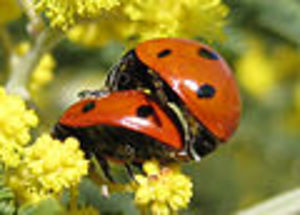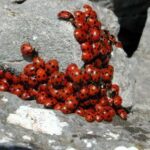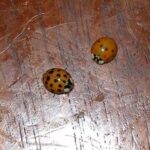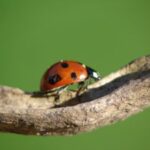Out of all the insects found worldwide lady bugs have to be some of the most charming. Although there are many varieties, you have to admit they all just look “cute”. After seeing lady bugs in your garden, on a rose or your favorite flowers you may have become curious and want to know a few facts about ladybugs. To explore facts about ladybugs we will discuss what lady bugs look like, eat, reproduction, how they live, enemies and where you can purchase lady bugs.
What Lady Bugs Look Like
Another cute fact about ladybugs is that you might not even recognize them. Many of us think of lady bugs as always being a shade of orange with black spots. Did you know some have checkerboard patterns while others are striped?
Shapes are similar with some being dome-shape, oval or round and all are small sized insects. The majority of common lady bugs are red, orange or yellow with some form of black markings. To add another twist to their appearance you may even find some that have red spots with a black shell and oddly enough, other types may have no spots whatsoever.
Little lady bugs have an exoskeleton, which appears as more of a shell to us and a pair of wings. Their body also consists of an abdomen, which contains the stomach and other associated parts. Lady bugs have a head, antennae and three pairs of legs. Antennae are a very important part of the body providing a sense of touch, smell and taste.
What Lady Bugs Eat
Lady bugs favorite food is the aphid. If aphids are in short supply lady bugs will feed upon the eggs of moths, mites, beetles and thrips. Gardens, farm crops and fields provide plants and crops where lady bugs find their food sources. An average ladybug will consume at least 50 aphids in a single day. In addition, they feed on flower pollen and nectar. Aphids do their feeding upon rose bushes and the best way to get rid of them is with hungry, ladybugs.
How Lady Bugs Reproduce
Female lady bugs will lay anywhere from as little as 20 eggs up to 1,000 in a 3-month period. If you look closely you may see cream, orange or yellow spindle-shaped eggs attached to leaves or plant stems. Mating between the female and male ladybugs occurs each summer and springtime. A female may not lay her eggs right away, but store them for as long as 2 or 3 months before she deposits them.
How Lady Bugs Live
After female and male lady bugs mate, she may drop little batches of eggs. Ladybugs even plan for their offspring, by purposely laying them close to aphid colonies, This positions the newly hatched lady bugs within sight of nutritious aphids.
Eggs develop into larva and eventually shed their skin to appear as tiny black insects with a striped or spotted appearance. They enter the pupa stage and emerge in about 12 plus days. These young adults have no spots at all and their color is pale compared to mature adults. At this stage they continue to develop into a full sized adult with bright colors, wings and some have spots.
Lady Bugs and Enemies
Did you know that nature helps this little insect with bright colors for a very good reason? Typically, in the predator and bug world any insects with bright colors act as a warning to birds and predators, because they are often poisonous or taste bad.
Have you ever walked by a plant and seen a ladybug all curled up and thought the poor thing was dead? If you did then their trick worked pretty well. Ladybugs play dead as a defense against their enemies even to the point of excreting a tiny dab of blood.
Buying Lady Bugs
Local garden supply stores and nurseries carry small packages of live lady bugs for sale at the check-out counter. You can also purchase them online from many of the gardening websites.
You might find lady bugs listed as ladybugs, ladybirds or lady beetles. I hope you found “Cute Facts About Ladybugs” fun and interesting. It wouldn’t hurt to get your own batch of lady bugs for natural aphid control in your rose garden.
Sources:
http://everything-ladybug.com/ladybug-facts.html
http://www.ladybuglady.com/LadybugsFAQ.htm








